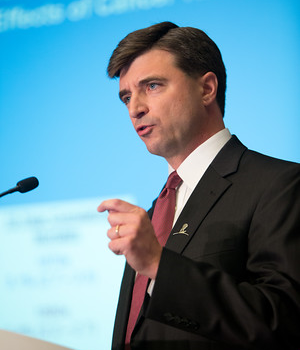Reduction in Late Mortality Improves Childhood Cancer Survival
An analysis of more than 34,000 5-year survivors of childhood cancer treated over 3 decades finds that modern treatments have reduced long-term mortality rates.
Gregory T. Armstrong, MD, presenting the study findings. Photo © ASCO / Scott Morgan 2015.

An analysis of more than 34,000 5-year survivors of childhood cancer treated over the course of 3 decades finds that modern treatments have reduced long-term mortality rates, in part due to refined treatment approaches that reduced mortality related to secondary cancers, as well as heart and lung disease, according to a presentation at the 2015 American Society of Clinical Oncology (ASCO) Annual Meeting, held May 29 to June 2, in Chicago.
“The Childhood Cancer Survivor Study cohort provides evidence that survivors in more recent eras have a significant reduction in late mortality attributable to fewer deaths from treatment-related causes, including subsequent malignancies and cardiac deaths. The strategy of reducing the intensity of therapy to lower the occurrence of late-effects, along with promotion of early detection and improved treatment of late-effects has now translated to extend the lifespan of survivors,” lead author Gregory T. Armstrong, MD, a pediatric oncologist at St. Jude Children’s Research Hospital, told a media briefing.
More than 80% of children with a malignancy will survive for 5 years. “However, among 5-year survivors, 18% will die within 30 years of diagnosis. Strategies have reduced late effects by reducing treatment intensity,” said Armstrong. “For the first time, we are able to attribute this strategy to a significant reduction in deaths.”
The study (abstract LBA2) evaluated data of long-term health outcomes in 5-year survivors of childhood cancer diagnosed between 1970 and 1999. The National Death Index was used to assess mortality among 34,043 5-year childhood cancer survivors. All were younger than 21 years at diagnosis.
After an average follow-up of 21 years since diagnosis, 3,958 (12%) patients had died, with 1,618 of those deaths from other health-related causes, including death due to late effects of cancer therapy. What’s more, all-cause mortality was halved-12.4% of patients diagnosed in the early 1970s died within 15 years of diagnosis as compared with only 6% of those diagnosed in the early 1990s.
The 15-year cumulative mortality rate from other health-related causes decreased from 3.1% in the 1970s to 1.9% in the 1990s. Survivors diagnosed in more recent years had a statistically significant lower risk of dying from other health-related causes, according to Armstrong, including a second primary cancer, and heart or lung disease.
“We developed a scale to measure tumor intensity,” Armstrong said. The study team noted reductions in mortality were due to fewer deaths related to late effects. This was most striking among survivors of Wilms tumor, Hodgkin lymphoma, and acute lymphoblastic leukemia (ALL). Cardiac mortality decreased significantly in ALL (P = .003), Hodgkin lymphoma (P = .06), and Wilms tumor (P = .04). Subsequent malignancy mortality decreased significantly in Wilms tumor (P < .001).
Reducing the intensity of therapy for many pediatric cancers led to a favorable prognosis, without compromising effectiveness. Treatment changes included reduced cranial radiotherapy and reduced use of anthracyclines for leukemia, limited chest radiation for Hodgkin lymphoma, and reduced abdominal radiotherapy dose and volume as well as fewer anthracyclines for Wilms tumor, he said.
“Improvements in supportive care for survivors, and screening, detection, and treatment of late effects, like new cancers and heart and lung disease, have played an important role in extending their lifespan as well,” added Armstrong.
Newsletter
Stay up to date on recent advances in the multidisciplinary approach to cancer.
Highlighting Insights From the Marginal Zone Lymphoma Workshop
Clinicians outline the significance of the MZL Workshop, where a gathering of international experts in the field discussed updates in the disease state.